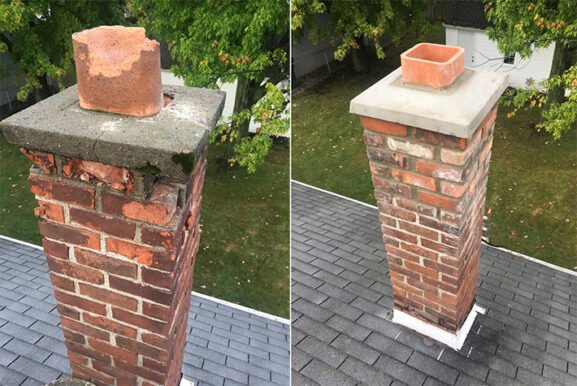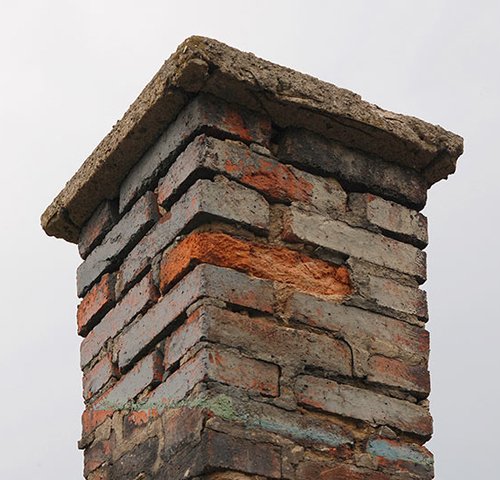Why Heat Shield Chimney Repair Should Never Be Ignored in Aging Homes
Key Takeaways
- Chimney flue damage can lead to serious fire and health hazards if not repaired properly
- Heat shield chimney repair is a cost-effective way to restore flue integrity without full replacement
- Cracked or deteriorating flue tiles often go unnoticed until a chimney inspection reveals the issue
- Professional application of a heat shield system ensures your chimney operates safely and efficiently
Understanding the Role of a Chimney Flue and Why It Fails
Your chimney’s flue is its internal lining, designed to contain high temperatures, toxic gases, and combustion byproducts from your fireplace or appliance. When it’s intact, the flue allows smoke and gases to safely exit your home. But over time, exposure to extreme heat, moisture, and creosote can cause the flue liner to crack or crumble.
A compromised flue is more than a minor maintenance issue. Even small gaps or fractures can let hot gases or flames reach surrounding materials like wood framing. This not only increases the risk of chimney fires but can also allow dangerous gases such as carbon monoxide to enter your living space.
Unfortunately, many homeowners don’t realize their flue is damaged because the symptoms aren’t always visible from outside. That’s why regular chimney inspections are essential, especially in older homes or properties that use the fireplace frequently.
What Is Heat Shield Chimney Repair and How Does It Work
Heat shield chimney repair is a modern restoration technique used to repair and reline damaged clay tile flue liners. Instead of tearing out and replacing the liner entirely, certified chimney professionals use a specialized cerfractory (ceramic and refractory) sealant to resurface the interior of the flue.
There are generally three approaches to heat shield repair:
- Joint repair system: Used when mortar joints between tiles are cracked or missing
- Resurfacing system: Ideal for flues with widespread surface cracks or deterioration
- CeCure sleeve system: Used when structural reinforcement is needed in severely damaged liners
Each of these methods involves cleaning the flue, preparing the surface, and applying the repair material using custom brushes or inflatable applicators to ensure even coverage and long-term durability.
The result is a flue liner that regains its smooth surface, resists heat damage, and prevents toxic gases from leaking into the home.
Signs Your Chimney Might Need a Heat Shield Repair
Because flue liner damage is hidden inside the chimney, homeowners rarely notice it until it causes problems. However, there are several warning signs that could suggest an internal issue:
- Persistent smoke backing up into the room when using the fireplace
- A strong odor coming from the chimney, especially during warmer months
- White staining or efflorescence on the chimney exterior
- Loose pieces of tile or mortar found in the firebox
- Water infiltration inside the chimney structure
If your home has never had a chimney video inspection, or if it has been more than a year since the last one, it’s wise to schedule an appointment with a certified chimney professional. Modern inspections use internal cameras to identify even minor defects in the flue liner that could be addressed early through heat shield repairs.
Why Heat Shield Repair Is Often a Better Option Than Full Relining
Full chimney relining can be expensive and disruptive, especially if the existing flue must be demolished and rebuilt. In contrast, heat shield repair offers a practical, cost-effective solution that restores safety without the need for complete replacement.
For homes with moderately damaged clay tile liners, heat shield systems offer several benefits:
- Minimal demolition required
- Reduced labor and material costs
- Preserves the original chimney structure
- Extends the life of your fireplace system
Additionally, heat shield systems are tested and approved under UL 1777 standards when applied by certified technicians. This ensures compliance with modern safety codes and provides homeowners with peace of mind.
According to the Chimney Safety Institute of America (CSIA), using cerfractory-based systems to reline or repair chimneys is a widely accepted industry practice, especially for existing clay tile flues (CSIA HeatShield Info).
The Importance of Hiring Qualified Technicians for the Job
Unlike cosmetic fireplace upgrades or exterior tuckpointing, heat shield repairs involve critical safety components that must be handled professionally. Improper application or incomplete coverage could allow heat or gases to escape the chimney system.
Look for contractors who are certified by organizations such as the CSIA or the National Fireplace Institute (NFI). These professionals follow industry-standard procedures, use approved products, and can provide documentation for insurance or code compliance.
Ask whether they use video scanning technology before and after repairs. This not only identifies the exact areas needing repair but also verifies the success of the repair once the work is completed.
A professional-grade heat shield application should last for many years when maintained properly and inspected annually.
Maintaining Your Chimney After Repair to Maximize Its Lifespan
Once your chimney has been repaired with a heat shield system, regular maintenance becomes even more important to keep it functioning safely. Schedule annual chimney inspections to catch any early signs of wear or new damage. Also, avoid burning unseasoned wood, which can accelerate creosote buildup and lead to future issues inside the flue.
Consider installing a chimney cap to prevent water, animals, and debris from entering the system, which can cause internal damage over time. Proper draft control, moisture protection, and sweeping are also key to preserving the newly restored flue liner.
Maintaining a chimney isn’t just about aesthetics—it’s about protecting your home and family from hidden fire hazards that could otherwise go undetected.
Why Routine Flue Assessments Matter for Long-Term Safety
Staying ahead of chimney problems means being proactive. Heat shield chimney repair offers an advanced, non-invasive way to bring your flue liner back to safe operating condition. When paired with routine chimney assessments, this approach can help extend the life of your chimney system, improve indoor air quality, and give you confidence every time you light a fire.
By understanding the signs of flue damage and trusting certified professionals to handle repairs, you make a smart investment in your home’s long-term safety and efficiency.

